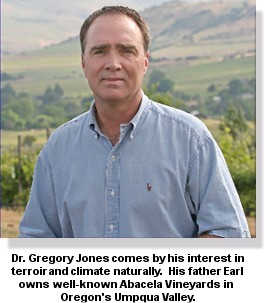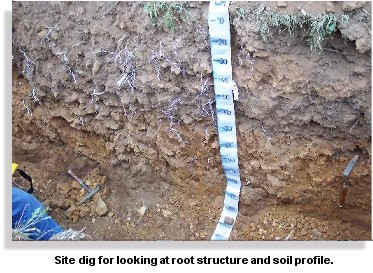|
Wine News & Reviews A R C H I V E
Technical Terroir New vineyards are risky business ventures, as any grape grower will tell you. And with the steep increase in wine production over the last couple decades, the industry has only become more competitive. In addition, climate change has added another troubling variable. In this uncertain environment, how does an up-and-coming grape grower reduce his or her risk and increase the chances of successful existence?
To keep some of this uncertainty at bay, growers enlist the aid of
scientific analysis, particularly studies of the climate, topography, and
soil of a potential site. Greg Jones, Professor in the Geography Department
at Southern Oregon University, specializing in Climatology, is one of the
recognized
Before looking at Jones’ methods, it is first important to understand the concept of terroir. This word gets tossed around frequently at wine tastings and is often merely understood as “soil.” However, terroir means a great deal more. “There’s no real translation into English,” explains Jones. “It’s an all-encompassing term that considers climate, soil, plant, and the grower; all contribute towards a particular product.” When one talks about grapes coming from a specific region, Jones explains, all of these factors come into play. For his analysis, Jones consults a multi-stage Geographic Information System (GIS), which consists of an extensive system of databases on established vineyards. This system includes details on all the terroir components, ranging from climate to elevation to soil composition. With this information, Jones categorizes the types of regions where specific grapes varieties have fared best. When it comes to planning for new vineyards, Jones looks at data on the prospective land and compares it to the established results. With so many factors to consider, one must make intelligent compromises based on the priority of the terroir components. According to Jones, climate takes priority. “For example, you can’t grow Pinot Noir in Bakersfield, California, and Merlot needs warmth in order to ripen.” If you want to grow Pinot Noir, you’ll need a climate range that is cool to intermediate, and for Merlot, one that is warm. Climate has its own list of qualities that need to be measured in order to determine site suitability: winter minimum temperatures, growing season length, sunshine hours, and precipitation index, to name just a few. Variations in topography and elevation can cause these qualities to shift significantly within a relatively small area; it’s not enough to take readings from one station and say they represent an overall region. “In the technical world,” says Jones, “we can take the limited knowledge that stations can give us and disperse it across the landscape into grid models.”
Using PRISM (Parameter-elevation Regressions on Independent Slopes Model),
analysts can determine specific climates down to a 1.45-mile resolution,
which is useful for pinpointing microclimates. Landscape ranks next in importance when considering a vineyard site. A site can have an ideal climate for growing grapes, but if the landscape doesn’t meet the necessary requirements, a vineyard won’t succeed. Conversely, a climate may seem borderline in its suitability, but if the landscape offers ideal sun exposure, the land may be workable. Landscape can be broken down into three basic components: elevation, slope, and aspect (the direction that the slope is facing). These components are analyzed using United States Geological Survey 10-meter digital elevation models (DEM). Then, the landscape is categorized according to what existing vineyards have revealed as most advantageous. For example, grapes do best grown on slopes within the 5-15% grade range and on southerly facing slopes. So, the analysis seeks out those landscapes that meet (or come close to) this criteria. The last step in the analytic process looks at soil suitability. Like the other elements of terroir, soil has its own properties that need to be considered. These are drainage, depth to bedrock, available water-holding capacity, and pH. Jones analyzes data that has been obtained by the State Soil Geographic (STATSGO) Data Base to determine sites that have the most appropriate soil. Drainage is given priority when establishing a vineyard, but this must be balanced with water-holding capacity; a suitable site needs to drain well, but retain enough water to weather moderate drought. Depth to bedrock also indicates how well vines deal with dry periods, with 30-40 inches as the standard. Soil pH reflects the fertility and nutrient balance in the soil, and research has shown that vineyards do best in a range of 5.5-8.0. Soil analysis sounds like an enormous task, however, not every part of the terrain need be sampled. Strategic low and high values are taken for mapped areas; then mean or true averages (depending on the soil component being measured) are calculated. Jones admits it is “harder to get a handle on soil analysis" than other components of terroir, but having some basic data is useful. As more data is collected about vineyards and climates throughout the world, climatologists such as Jones can be more accurate about estimating the suitability of future sites. They also are beginning to see trends indicating global warming and can make educated predictions about regions that aren’t currently seen as grape growing sweet spots. The work currently being done in Washington State’s Puget Sound is an excellent example of such progress. Traditionally, the Puget Sound AVA has been thought of as too cool to host many varieties. However, Jones’ methods can help growers determine the best areas for growing grapes that prefer cooler climates, including the German white grape hybrid Madeline Angevine. With its citrus and herb qualities, a winemaker could create sparkling, dry, and late harvest wines…and how many places can offer such a variety of styles based on one grape? Growing something as distinctive as Madeline Angevine would set off the Puget Sound as a memorable AVA. This suggestion is just one option for growing grapes in the Puget Sound. Another is to look at climate warming trends and begin preparing for future climates. “If you look out to the year 2050,” says Jones, “climate models [in the Puget Sound] will be more like the center of the Willamette Valley. Warming by just an average of 2.3 degrees Fahrenheit over 50 years will take [the area] from cooler to more mainstream temperatures.” Jones concludes it’s very likely that the Puget Sound will become the next Pinot Noir growing region in a couple generations. Preparing for climate change is probably the most uncertain aspect of grape growing. Analysis of past trends helps somewhat, but one of the best ways to assess what an area can grow is to experiment. “Grape growers should have a small plot where they’re trying other things,” suggests Jones. For example, a Puget Sound grower could start with Madeline Angevine but reserve some space for Pinot Noir to see how it fares over time. Geographical analysis is not a foolproof approach for determining a vineyard’s future success. After all, part of terroir also comes from the traditions of viticulture and viniculture in a certain area. Analysis can highlight a site’s potential, but it takes skill and familiarity with the region to fulfill that potential. All things considered, today's analytic technologies are a sound investment in tomorrow's vineyard successes, reducing guesswork and risk for growers worldwide.
Copyright © 2006 -
June, 2020 Susan R. O'Hara. All rights reserved. |

 experts
of compiling the data from these studies into a format growers can use to
inform their latest ventures.
experts
of compiling the data from these studies into a format growers can use to
inform their latest ventures. 


